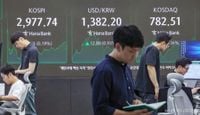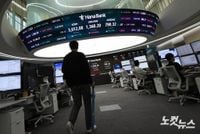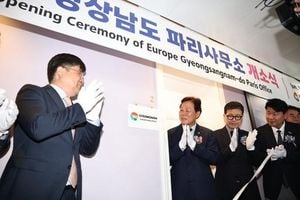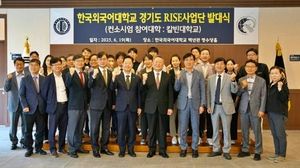On June 20, 2025, South Korea's benchmark stock index, the KOSPI, broke through the 3000-point barrier during intraday trading, a milestone it had not reached in over three years. The last time the index climbed above this level was on January 3, 2022, amid the global uncertainty of the COVID-19 pandemic, when it briefly hit 3010.77 points. This resurgence marks a notable moment for the South Korean stock market, reflecting a complex interplay of investor sentiment and global economic factors.
The day began with the KOSPI opening at 2986.52 points, representing a 0.29% increase from the previous day's close. However, the index initially dipped to around 2972 points in early trading hours, reflecting some early caution among investors. Despite this, by approximately 10:45 AM, the KOSPI surged to 3000.46 points, climbing 0.76% above the prior close. This intraday peak was met with enthusiasm, signaling renewed confidence among market participants.
Driving this upward momentum were strong buying activities by individual and foreign investors. Their recent aggressive purchasing helped offset concerns that lingered in the market, particularly geopolitical tensions in the Middle East and the cautious stance adopted by the U.S. Federal Reserve. These factors generally acted as headwinds, limiting the pace of gains but ultimately failing to prevent the milestone breakthrough.
Visual testimony to this market milestone was evident at the Hana Bank headquarters in Jung-gu, Seoul, where the dealing room's electronic boards proudly displayed the KOSPI index climbing past 3000 points. This moment was captured in photographs, symbolizing the market's resilience and the pivotal role of investor confidence in navigating uncertain times.
Meanwhile, sector performance on June 20 painted a mixed picture. The entertainment sector experienced a notable boost, with CJ CGV, a major player in the industry, soaring by around 11%, lifting the broader entertainment category by roughly 1%. Conversely, the construction sector faced pressure, declining by about 1%, weighed down by companies such as DL E&C, Hyundai Construction, and Taeyoung Construction. Other sectors like manufacturing, electricity and gas, transportation and warehousing, finance, telecommunications, general services, and real estate showed modest gains, hovering in positive territory, while retail and IT services edged slightly lower.
Among the top market capitalization stocks, SK Hynix stood out with a robust gain of approximately 3%, signaling strength in the semiconductor industry. KB Financial Group and Celltrion also posted moderate increases of around 1%. Giants like Samsung Electronics, Samsung Biologics, LG Energy Solution, and Shinhan Financial Group maintained steady, slightly positive movements. On the downside, Doosan Enerbility and Samsung C&T experienced declines of 2% and 1%, respectively, with Hanwha Aerospace, Hyundai Motor, Naver, and Kia showing minor losses.
The KOSDAQ, South Korea's secondary stock market, also reflected positive momentum on this day. At 9:13 AM, it stood at 787.45 points, up 4.94 points or 0.63% from the previous day. Individual investors were net buyers to the tune of 17.3 billion won, with foreign and institutional investors also contributing net purchases of approximately 9.9 billion won and 2.1 billion won respectively. The telecommunications sector led gains on KOSDAQ, buoyed by a remarkable 22% surge in Korea Telecom, pushing the sector up by about 4%. Other sectors including manufacturing, construction, retail, finance, general services, and entertainment showed modest positive trends, while transportation and IT services saw slight declines.
Leading KOSDAQ stocks included Samchun-dang Pharmaceutical, which rose around 4%, Silicon Works with a 3% gain, and companies like EcoPro BM, Rainbow Robotics, and PharmAbcine advancing by approximately 2%. EcoPro also posted a 1% increase. Meanwhile, Peptron experienced a minor decline of around 1%, and stocks such as Alteogen, Hugel, Rigakem Bio, and Kolon TissueGene remained relatively stable, with HLB and Lino Industry showing slight downward trends.
In currency markets, the South Korean won strengthened against the U.S. dollar, with the interbank exchange rate opening at 1375.4 won per dollar, down 4.8 won from the previous trading session's close. This appreciation may reflect a combination of factors, including the positive sentiment in the equity markets and broader economic conditions.
On the cryptocurrency front, Bitcoin traded on the Upbit exchange showed marginal gains, rising 0.02% to 104,500,600 won. The so-called 'Kimchi premium,' which measures the price difference of Bitcoin between South Korean exchanges and international markets, stood at 0.74%, indicating a modestly higher valuation domestically.
The KOSPI's breakthrough above 3000 points comes at a time of cautious optimism. While geopolitical risks in the Middle East and the Federal Reserve's careful approach to monetary policy remain concerns, the persistent buying by individual and foreign investors underscores a belief in the resilience and potential of the South Korean market. The mixed sector performances highlight the uneven nature of the recovery, with technology and entertainment sectors showing particular strength, while construction and certain large industrial stocks face challenges.
As the market continues to navigate these complexities, the 3000-point milestone serves as both a symbolic and practical benchmark, reflecting the evolving landscape of South Korea's economy and investor confidence. Whether this momentum can be sustained in the face of global uncertainties remains to be seen, but for now, the KOSPI's rise is a notable chapter in the country's financial narrative.





